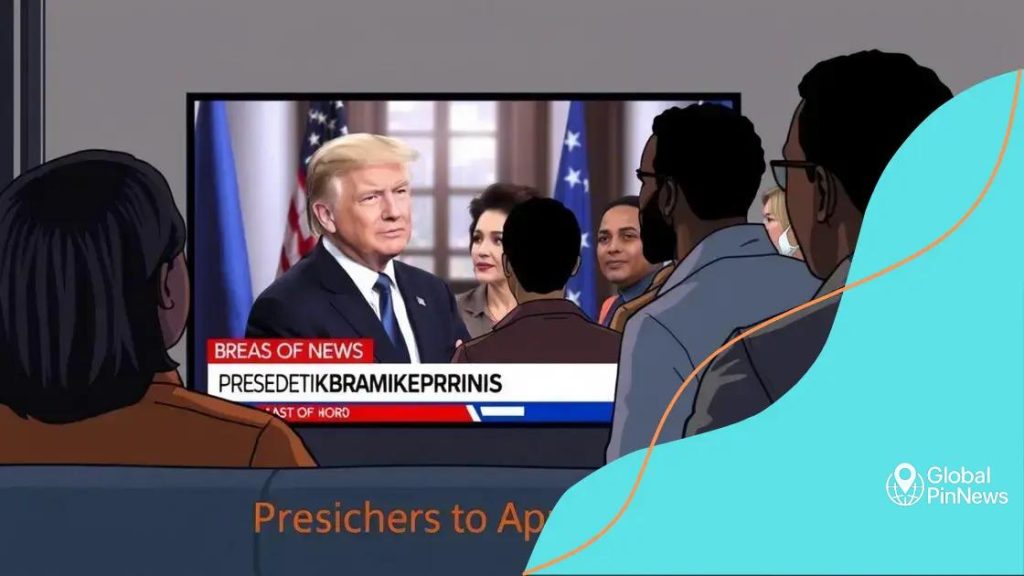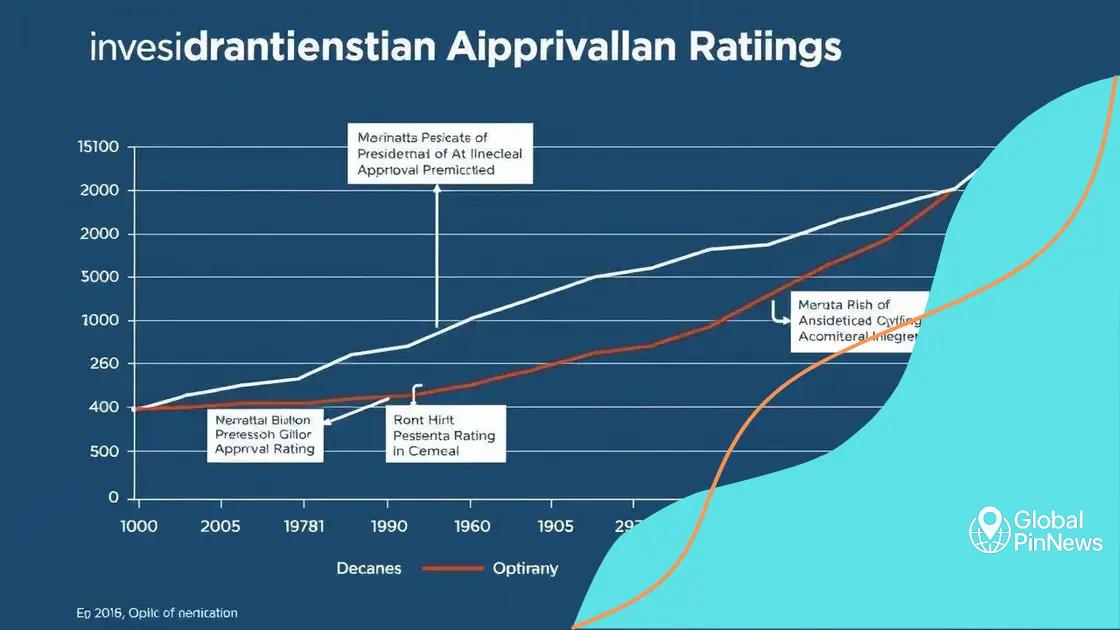Current presidential approval ratings: what they mean for you

Current presidential approval ratings significantly influence voter behavior and election outcomes, as higher ratings generally lead to greater support for the president’s party, while lower ratings can result in substantial losses during midterm elections.
The current presidential approval ratings play a crucial role in shaping public opinion and influencing voter behavior. Ever wondered how these ratings affect your life and decisions? Let’s dive deeper into this intriguing topic.
Understanding the significance of approval ratings
Understanding the significance of approval ratings is essential for grasping how public opinion shapes political landscapes. These ratings reflect how much trust and support a president has from the public. They can influence decisions made by leaders and political strategies.
Why Approval Ratings Matter
Approval ratings matter for several reasons. They serve as a gauge for how well the president is perceived and can impact their ability to implement policies. When numbers are high, it often suggests that the public supports the president’s actions. On the other hand, low ratings may indicate dissatisfaction and can lead to difficulties in governance.
- High approval ratings can boost a president’s confidence in implementing policies.
- Low ratings may limit a president’s influence in Congress.
- They can predict electoral outcomes for upcoming elections.
These ratings are not just numbers; they hold the power to sway public perception. For instance, when a crisis occurs, a president’s ratings may fluctuate dramatically. This can be due to how effectively they manage the situation, and the public’s response is often reflected in these ratings.
Impact on Governance
The impact of approval ratings on governance is profound. Politicians closely monitor these ratings to shape their agendas. If the ratings are falling, a president might shift focus to popular initiatives to regain public support. Additionally, parties may adjust their strategies based on the current approval landscape, determining which issues they need to emphasize.
- Approval ratings influence legislative priorities.
- They can affect the funding of certain projects.
- Leadership styles may change depending on public perception.
Overall, understanding approval ratings provides insight into the dynamics of political power. It reveals how leaders are held accountable and responds to the needs of their constituents. As voters, being aware of these ratings helps us understand the broader implications of political decisions.
Factors influencing presidential approval
Various factors influence presidential approval ratings, and understanding these can provide deeper insights into the political climate. Economic conditions, national events, and public perception of leadership all play vital roles in shaping how citizens view their president.
The Economy’s Role
The state of the economy is one of the most significant influences on presidential approval. When the economy is thriving, approval ratings tend to be higher. Conversely, during economic downturns, leaders often experience a decline in support. This relationship underscores how closely people link their personal wellbeing to national leadership.
- Low unemployment rates typically correlate with higher approval ratings.
- Inflation and rising living costs can lead to dissatisfaction.
- The public reacts strongly to changes in economic policies.
These economic indicators serve as a mirror reflecting the public’s feelings towards the presidency. As economic situations shift, so do the perceptions of how well the president is performing.
Impact of Major Events
Major events, such as natural disasters or international conflicts, can also sway approval ratings. For instance, a president’s response to a crisis can either bolster their ratings or lead to a significant downturn. Public perception of a president’s effectiveness during emergencies is critical.
- Effective crisis management can enhance voter trust.
- Poor responses may result in a loss of confidence.
- Media coverage greatly amplifies public reactions.
Media representation of presidential actions plays a crucial role in shaping those perceptions. Public opinion often shifts based on how news outlets portray a situation, reinforcing the importance of communication strategies in leadership.
Another factor to consider is public perception of character and integrity. Citizens value authenticity and accountability from their leaders. A president’s behavior, both in office and in public, can impact their overall approval ratings. The way voters perceive a leader’s ethics shapes their trust and willingness to support policy choices.
Comparing historical approval ratings

Comparing historical approval ratings offers valuable insights into how public perception of presidents has changed over time. By examining past leaders, we can understand patterns and draw connections to current administrations. This analysis helps us see how different factors influenced their ratings.
Trends Over Time
Historically, approval ratings fluctuate significantly in response to major events. For instance, presidents like George W. Bush saw a rise in approval after 9/11, while others like Richard Nixon faced dramatic declines during scandals like Watergate. These shifts illustrate how external circumstances can shape public opinion quickly and powerfully.
- High approval ratings often follow military victory or national unity.
- Economic crises typically lead to falling approval.
- Scandals can dramatically alter public trust in leadership.
These examples show that approval ratings are not static; they evolve based on the political climate and decisions made by the president.
Comparative Analysis
When comparing past approval ratings, it’s essential to consider the context and challenges each president faced. For example, Franklin D. Roosevelt experienced high ratings during the New Deal, as citizens rallied behind his efforts to combat the Great Depression. In contrast, more recent presidents have faced rapid information dissemination through social media, affecting how quickly public opinion can shift.
- Presidents are now scrutinized continuously due to instant news cycles.
- Public reaction can be almost immediate, leading to volatile approval ratings.
- The role of social media has changed how ratings are interpreted.
This contemporary dynamic underscores the importance of understanding historical contexts to interpret current approval ratings accurately. Analyzing these trends helps us predict how future events might influence the popularity of current or future leaders.
The impact on midterm elections
The impact of presidential approval ratings on midterm elections is significant. These ratings serve as a reflection of public sentiment and can greatly influence election outcomes. When a president enjoys high approval, their party often fares better during midterms.
High Approval Ratings
When approval ratings are elevated, incumbents are more likely to retain control of Congress. Voters tend to support candidates from the party of a popular president. This is seen as a vote of confidence in the administration’s policies.
- Higher voter turnout usually accompanies strong approval ratings.
- Incumbent candidates typically receive more funds and support.
- Party unity often strengthens with positive perceptions.
During these years, the party in power can leverage the president’s popularity to promote its agenda more effectively.
Low Approval Ratings
Conversely, when approval ratings drop, the midterm elections can lead to significant losses for the president’s party. Voters may express dissatisfaction by switching their support to the opposing party. This change can lead to swings in control between political parties.
- Low ratings can lead to decreased voter enthusiasm.
- Challengers often gain traction with promises of change.
- Incumbents may face difficult races even in safe districts.
As a result, low approval ratings often result in what is known as a “midterm wave,” where the opposing party gains seats dramatically.
Understanding the connection between presidential approval and midterm elections helps voters make informed decisions. Analyzing past elections shows that approval ratings not only reflect the current political climate but also forecast future changes in Congress.
Public perception and media influence
Public perception heavily influences presidential approval ratings, and the media plays a crucial role in shaping that perception. News coverage, social media, and public discourse can enhance or diminish how people view their leaders.
The Role of Media Coverage
Media coverage directly affects how the public perceives presidential actions. For instance, positive reporting on a president’s achievements can bolster approval ratings, whereas negative stories can quickly reverse that trend. The way media frames issues—whether focusing on successes or failures—shapes public opinions significantly.
- Breaking news events often sway public perception in real-time.
- Editorial choices can impact the tone of political dialogues.
- 24/7 news cycles ensure that public figures are constantly scrutinized.
In this fast-paced environment, the media’s portrayal becomes a powerful tool in influencing voter sentiment.
Social Media Impact
Social media has transformed how information is disseminated and consumed. Platforms like Twitter and Facebook allow for immediate reactions and spread information quickly. A single tweet or post can influence the public’s mood regarding a president instantly. This rapid exchange of views provides a powerful avenue for both supporters and critics to express their opinions.
- Social media enables grassroots movements to flourish.
- It allows for direct communication between leaders and citizens.
- Misinformation can spread quickly, impacting public opinion.
Moreover, social media creates echo chambers, where people often surround themselves with like-minded individuals, reinforcing their views and impacting perceptions of approval rates.
Understanding the dynamics between public perception and media influence is vital. As voters, awareness of how these factors interact can lead to more informed opinions about political leadership and decision-making.
FAQ – Frequently Asked Questions About Presidential Approval Ratings
What are presidential approval ratings?
Presidential approval ratings are measurements of how much support a president has from the public, often reflecting their satisfaction with the president’s performance.
How do approval ratings affect elections?
High approval ratings typically lead to better outcomes for the president’s party in elections, while low ratings can result in significant losses, especially during midterms.
What role does the media play in shaping public perception?
The media influences public perception by highlighting presidential actions and events, which can sway approval ratings up or down based on coverage.
How does social media impact approval ratings?
Social media provides immediate feedback and allows rapid spread of information, affecting public opinion and approval ratings almost instantly.
